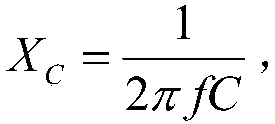Microplastic detection apparatus based on dielectric constant identification
A technology of dielectric constant and detection device, which is applied in the field of environmental monitoring and identification and detection of microplastics in environmental media, can solve the problems of high requirements for analysis of environmental conditions, difficult to sample on-site rapid detection, and high analysis costs, and achieves fast and simple measurement. , Wide range of application, simple operation effect
- Summary
- Abstract
- Description
- Claims
- Application Information
AI Technical Summary
Problems solved by technology
Method used
Image
Examples
Embodiment
[0037] Example: Measure the capacitance of polyethylene, polyvinyl chloride, polypropylene, polystyrene, and ABS standard plastic particles respectively, record the corresponding voltage and current, calculate the dielectric constant of the medium corresponding to each plastic, and repeat the test three times , taking the average value as a reference.
[0038] 1) Mix 10g polyethylene, 5g polyvinyl chloride, and 5g polypropylene plastic particles, weigh 1g of the mixed material for identification, repeat the test three times, compare the experimental data with the reference value, determine the type of plastic particles, and finally succeed Identify three types of plastic particles, with an overall recognition rate of 94%.
[0039] 2) Mix 10g of sand and 10g of polyethylene plastic particles, weigh 1g of the mixed material for identification, repeat the test three times, and successfully identify polyethylene and sand.
[0040] 3) Test the collected sediment samples, repeat th...
PUM
| Property | Measurement | Unit |
|---|---|---|
| size | aaaaa | aaaaa |
| size | aaaaa | aaaaa |
Abstract
Description
Claims
Application Information
 Login to View More
Login to View More - R&D
- Intellectual Property
- Life Sciences
- Materials
- Tech Scout
- Unparalleled Data Quality
- Higher Quality Content
- 60% Fewer Hallucinations
Browse by: Latest US Patents, China's latest patents, Technical Efficacy Thesaurus, Application Domain, Technology Topic, Popular Technical Reports.
© 2025 PatSnap. All rights reserved.Legal|Privacy policy|Modern Slavery Act Transparency Statement|Sitemap|About US| Contact US: help@patsnap.com



